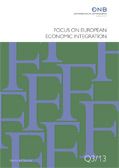Focus on European Economic Integration Q1/15
 OeNB
OeNB
- Erschienen:
- März 2015.
 OeNB
OeNB
Call for Entries: Olga Radzyner Award 2015 for Scientific Work on European Economic Integration (PDF, 57 kB) Focus on European Economic Integration Q1/15 en 31.03.2015, 00:00:00
Call for Applications: Visiting Research Program (PDF, 56 kB) Focus on European Economic Integration Q1/15 en 31.03.2015, 00:00:00
Sectoral Deleveraging in Europe and Its Economic Implications
(PDF, 530 kB)
Gächter, Geiger, Glötzl, Schuberth.
Martin Gächter, Martin Geiger, Florentin Glötzl, Helene Schuberth – Focus on European Economic Integration Q1/15
We examine net lending/net borrowing and the underlying debt dynamics at the sectoral level in the European Union. Saving and investment patterns indicate that there have been considerable deleveraging efforts since the start of the global financial crisis, particularly in the nonfinancial corporate and household sectors. In many EU countries, however, this decline in credit transactions has not yet led to a significant reduction of sectoral debt-to-GDP ratios.
Subdued output growth and low or even negative inflation rates have undermined the
deleveraging process and increased real debt burdens in a number of European economies.
Since these are often the countries that had experienced strong credit booms prior to the
crisis, rebalancing needs are likely to persist and may be a significant drag on the recovery in the near future. Furthermore, most of the ongoing rebalancing – both in terms of debt levels and current account deficits – is based on a sharp decline in investment rather than an increase in saving, which might lead to lower potential growth in the future. Recent developments may even jeopardize the catching-up process of peripheral euro area countries and non-euro area EU Member States in Central, Eastern and Southeastern Europe.
en
balance sheet recession, financial accelerator, credit crunch, investment
E22, E24, E44, G21, G31
31.03.2015, 00:00:00
A Local or a Foreign Currency Loan? Evidence on the Role of Loan Characteristics, Preferences of Households and the Effect of Foreign Banks
(PDF, 424 kB)
Beckmann, Roitner, Stix.
Beckmann, Roitner, Stix – Focus on European Economic Integration Q1/15
Using data from the OeNB Euro Survey in CESEE, which covers both EU Member States and (potential) candidate countries, we analyze how the currency of existing loans to households relates to (1) loan characteristics (loan maturity and purpose), (2) households’ preferences regarding the loan currency and (3) bank ownership (domestic or foreign). Our findings support the existing literature’s view that both demand- and supply-side factors have an influence on foreign currency lending. In the period under investigation, foreign currency loans were sought after by households in particular for long-term borrowing. Likewise, banks were more likely to grant large and long-term loans in foreign currency. On a descriptive level, we find that in Croatia and Hungary, foreign-owned banks had a higher share of foreign currency loans than local currency loans – in the remaining seven countries, however, the share of foreign currency loans is similar to or lower than that of local currency loans. In regression models we account for the possibility that foreign-owned and domestically-owned banks may differ in that they have issued loans with different characteristics and in that they have customers with different
credit ratings and different preferences. Holding these factors constant reveals that, on average, foreign-owned banks did not issue more foreign currency loans – neither consumption loans nor mortgages – than domestically-owned banks.
en
foreign currency debt, household credit, bank ownership, Central, Eastern, Southeastern Europe
D14, G21, F34
31.03.2015, 00:00:00
Price and Wage Rigidities in the Republic of Macedonia: Survey Evidence from Micro- Level Data
(PDF, 485 kB)
Huber, Petrovska.
Huber, Petrovska – Focus on European Economic Integration Q1/15
This paper exploits the information collected from an ad hoc survey conducted on a sample of Macedonian firms to study the extent of nominal price and wage rigidities in the Republic of Macedonia. The research was motivated by the observation that sticky prices influence the responsiveness of inflation to changes in a central bank’s policy rate.
Against this background, the paper investigates the relative importance of most determinants of the frequency of price and wage changes identified in the literature. This paper presents a Bayesian analysis of ordinal data. Posterior inference is carried out using Markov Chain Monte Carlo (MCMC) techniques. Infusing the model with prior information allows us to shrink the parameter space, resulting in more precise and reliable parameter estimates.
Our results suggest that higher price flexibility is associated with a higher degree of product market competition.
Specifically, we find that firms facing high levels of domestic and international
competition tend to adjust prices faster.
en
price rigidity, wage rigidity, Bayesian inference, MCMC, survey data
D21, E30, J31
31.03.2015, 00:00:00
CESEE-Related Abstracts from Other OeNB Publications (PDF, 89 kB) en 31.03.2015, 00:00:00
Conference on European Economic Integration 2014: The Rebalancing Challenge in Europe – Perspectives for CESEE (PDF, 132 kB) Focus on European Economic Integration Q1/15 en 31.03.2015, 00:00:00
Olga Radzyner Award Winners 2014 (PDF, 72 kB) Focus on European Economic Integration Q1/15 en 31.03.2015, 00:00:00
Hélène Rey on Monetary Policy and International Capital Flows Summary of the 19th Global Economy Lecture (PDF, 71 kB) Focus on European Economic Integration Q1/15 en 31.03.2015, 00:00:00
Notes (PDF, 154 kB) en 31.03.2015, 00:00:00